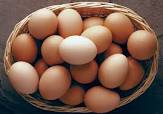THE EGG CYCLES

How are eggs produced? On factory fatms, where the vast majority of the global egg supply comes from, eggs are produced by subjecting female chickens, known as laying hens, to unbelievable acts of cruelty. Thousands of birds are crammed together, often in filthy, darkened places where the birds have almost no ability to engage in natural behaviors. Meanwhile, their bodies are pushed to produce as many eggs as possible: almost one a day. Compare that to a wild chicken, who would naturally lay close to 12 eggs in one year, and you’re confronted with a nearly 3,000% increase in egg production—3,000% more than what is ‘natural’ for a living, breathing hen. At the end of their abbreviated lives, hens are sent to the slaughterhouse, where they're destined to become cheap meat via a brutal process known as live shackle slaughter The life cycle of laying hens The life cycle of hens on factory farms are filled with exploitation at every turn. From birth until death, these birds are subjecte...